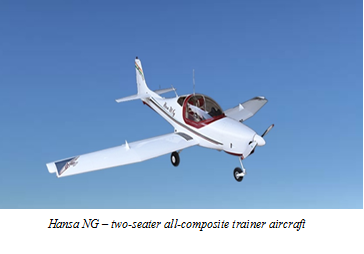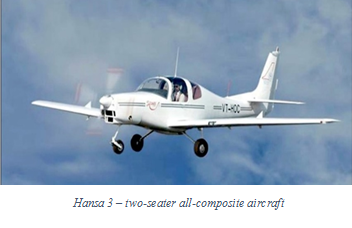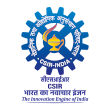The HANSA - Two Seat Aircraft for Pilot Training
The HANSA - Two Seat Aircraft for Pilot Training
 Flight training is defined as the use of an aircraft for the purpose of formal flight instructions with an instructor. The flights may be performed by aero clubs, flying schools or commercial operators. Every airline and military pilot begin their career in a 2 to 4 seat aircraft cockpit. A PricewaterhouseCoopers (PwC) Report suggests that approximately 50% of the 2 to 6 seat fixed-wing aircraft in India are being used for flying training purposes. Many these are imported aircrafts like Cessna 152 and Cessna 172 aircrafts. As per Ministry of Civil Aviation, due to the rapidly growing aviation market, there is a large requirement of pilots in the country, which creates immense opportunities for the small aircraft production industry.
Flight training is defined as the use of an aircraft for the purpose of formal flight instructions with an instructor. The flights may be performed by aero clubs, flying schools or commercial operators. Every airline and military pilot begin their career in a 2 to 4 seat aircraft cockpit. A PricewaterhouseCoopers (PwC) Report suggests that approximately 50% of the 2 to 6 seat fixed-wing aircraft in India are being used for flying training purposes. Many these are imported aircrafts like Cessna 152 and Cessna 172 aircrafts. As per Ministry of Civil Aviation, due to the rapidly growing aviation market, there is a large requirement of pilots in the country, which creates immense opportunities for the small aircraft production industry.
As per the Aero Club of India, most aircrafts with subsidized Flying Training Organizations (FTO’s) in India are now old and are increasingly becoming economically non-viable to operate. Therefore, all FTOs are actively looking to replace these aircraft, and HANSA aircraft of CSIR-National Aerospace Laboratories may be a good option.
The small aircraft market in India is predominantly dominated by foreign players where domestic players have no presence. As per the Market Survey conducted in 2017 by the PwC, the demand estimation based on their primary research is an immediate requirement of 70-80 aircraft for flying training in the country.
HANSA-3 Aircraft
CSIR-NAL has designed and developed Hansa-3 aircraft, an all-composite two-seat light trainer aircraft to be used as an ab-initio flying training machine for the flying clubs in India. This aircraft was certified in 2000 when flying clubs needed an advanced trainer aircraft of contemporary class. Hansa-3 aircraft was certified by DGCA under FAR-23 via JAR-VLA in February 2000. It has very good flying qualities, in particular, a docile low-speed behaviour, which makes it ideal for ab-initio flying training.
 Hansa-3 aircraft airframe was developed using the composite technology of 2000 by adopting hand layup, with vacuum bag moulding technique and rivet-less construction. Being completely made of fibreglass and carbon composite materials has the inherent advantage concerning corrosion resistance, damage tolerance, and reparability. Notable special features of Hansa are neat cockpit with good visibility, dual control with excellent control harmony (mandatory for trainer aircraft), rugged, operationally cost-effective and easy to maintain; extensively tested for certification compliance including lightning protection; day-night VFR flying capability and turbo-charged engine with constant speed propeller making it easy to operate even from runways at elevated altitudes and hot day conditions. CSIR-NAL has built 14 production version aircrafts from 2001 to 2010, out of which 11 were delivered to DGCA, one aircraft to IIT-Kanpur and two aircrafts are with CSIR-NAL. The cumulative hours logged by all Hansa-3 aircrafts is about 4000 hours. All the pilots who have flown Hansa-3 aircraft have similar opinions about its excellent flying characteristics. The aerodynamics, power and controls harmony make flying very comfortable.
Hansa-3 aircraft airframe was developed using the composite technology of 2000 by adopting hand layup, with vacuum bag moulding technique and rivet-less construction. Being completely made of fibreglass and carbon composite materials has the inherent advantage concerning corrosion resistance, damage tolerance, and reparability. Notable special features of Hansa are neat cockpit with good visibility, dual control with excellent control harmony (mandatory for trainer aircraft), rugged, operationally cost-effective and easy to maintain; extensively tested for certification compliance including lightning protection; day-night VFR flying capability and turbo-charged engine with constant speed propeller making it easy to operate even from runways at elevated altitudes and hot day conditions. CSIR-NAL has built 14 production version aircrafts from 2001 to 2010, out of which 11 were delivered to DGCA, one aircraft to IIT-Kanpur and two aircrafts are with CSIR-NAL. The cumulative hours logged by all Hansa-3 aircrafts is about 4000 hours. All the pilots who have flown Hansa-3 aircraft have similar opinions about its excellent flying characteristics. The aerodynamics, power and controls harmony make flying very comfortable.
HANSA-New Generation Aircraft
During the user interactions, the flying community suggested significant modifications on Hansa-3 aircraft to make it more useful as a trainer aircraft. The modifications included requirements of flying clubs for obtaining PPL (Personal Pilot License) & CPL (Commercial Pilot License) for their learners. The major modifications proposed were changing analogue instruments to digital state-of-the-art fully glass cockpit display system, reducing the pilot load by changing the mechanically operated flaps to electrical operations, ergonomically designed doors for better ingress and egress, increasing the fuel capacity for higher range and endurance, bubble canopy for an excellent aerial view, and easy to fly with good handling quality and low operations and maintenance cost.
With the above modifications to Hansa, the programme was launched in the latter half of 2018, and the Hansa-NG was rolled out on 31st March 2021. CSIR-NAL is happy to inform that, it has received Letter of Intent (LoI) for about 65 aircrafts from 7 flying clubs/flight training school. An MoU was signed between CSIR-NAL & Indira Gandhi Rashtriya Uran Academi (IGRUA) on 31st March 2021 for Hansa-NG to be the possible launch customer.
The availability of Hansa-NG will boost pilot training with indigenous aircraft. The defence sector can also use Hansa-NG for cadet training and coastal surveillance, furthering the development of a wide variety of small and medium scale private entrepreneurs in producing airworthy components. Further, it will help create an opportunity to give on the job training for ITI & Diploma holders in various aircraft building and AME training disciplines. Hansa NG would be an affordable and appreciable trainer aircraft for the young generation of pilots.
R Venkatesh
Head, Business Development
CSIR-National Aerospace Laboratories

 Pensioners Corner
Pensioners Corner Screen Reader Access
Screen Reader Access Skip to main content
Skip to main content























